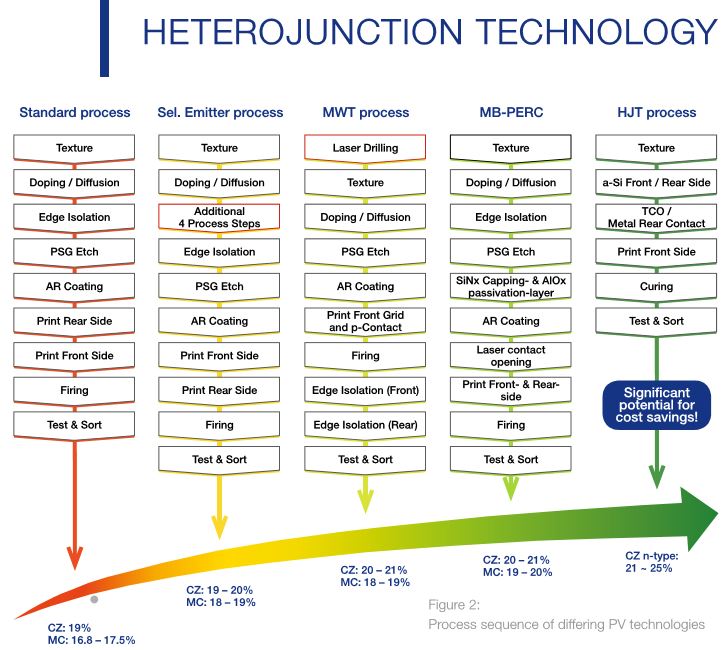REC Group is launching a new 380 watt solar module – with an (estimated by this author) efficiency of at least 22.4% based on comparable sizing – and it looks to be the first of a new generation to hit the market.
We get pretty headlines quite often in our field – record low prices, big money on new tech, flying solar, and even one or two with far out, world changing ideas. But most of these are far away from affecting most of us, though there is one ongoing rolling revolution that we are all in the midst of – the increasing efficiency of solar modules (and the effects they have on system pricing).
REC’s new module is on a monocrystalline silicon / amorphous silicon heterojunction platform made as a joint development between REC and Meyer Burger (with the sale probably announced back in December). Meyer Burger has long been suggesting that heterojunction is the solar cell of the future (pdf) and has a much higher efficiency potential – towards 25% cells, with greater than 24.2% already achieved – than the current mass market leader mono PERC.
Might we get to touch something shiny soon?
While the new module’s specification page won’t be released until Intersolar Europe in May, President REC Americas Cary Hayes took time with pv magazine USA to share some rough details.
Compared to REC’s 60 cell N-Peak product the new module will be within an inch of size on the long side, with a slightly lesser width (edit: the product was a bit larger than a inch on the longer side, and about a half inch larger on the width – leading to an official efficiency of 21.7%). The half cut solar cell will be packaged in standard aluminum; as well there will be a highly aesthetic all black model that is about a power class (~5 W) lower in peak performance (estimated >22.1% efficient).
The product will be aimed at the first mover types in the premium residential market, which – globally – is the most space constrained, while having the highest priced electricity. Specifically noted as part of Hayes’ market responsibility is that U.S. customers have shown a strong desire to keep up the curb appeal of their homes – so the pitch is that we’re maximizing efficiency with ultra-premium heterojunction high efficiency to limit total system size, while also sacrificing a just bit of efficiency with the black backsheets and black aluminum frame.
The module will be manufactured in a new building currently being built on the group’s Singapore campus. Hayes suggested there are 250-300 contractors working on the structure right now.
REC is targeting an annual manufacturing capacity of 600 MW and has allocated $150 million in investment capital. The goal is for first availability in Q4’19, with full production capacity being hit in 2020.

Meyer Burger documentation (from a few years ago) suggests heterojunction product can be made with a fewer number of machines (above image), meaning potential cost savings in the long run as the product type scales. In the REC press release there is a mention of a low temperature process – Meyer Burger’s SmartWire Connection Technology (SWCT) cell connection technology fits the bill (which REC selected Meyer Burger for early in 2018). As the heterojunction connection doesn’t work with high temperature manufacturing processes, the low temperature requirements of SWCT technology fit nicely.
Even further than today’s announcement, Meyer Burger suggested a SWCT module manufacturing line – using heterojunction cells – could produce modules with an efficiency level up to 26% (with research suggesting the theoretical peak of this technology above 29%).
Using silicon as the heterojunction base layer is also being considered by seeming perovskite leader Oxford PV – and interestingly, Meyer Burger is involved there as well. Except Oxford’s cell efficiency goal is greater than 30% in 2020.
It’s also quite interesting to speculate that a heterojunction technique could allow the currently existing silicon manufacturing supply chain to slip into a silicon plus thin film (or perovskite) solution with manufacturing line upgrades, versus full line replacements.
Whatever the path ends up being, it is without a doubt that this module is only the first in what will be a broad jump in product available to the mass market.
Edit: The product was a bit larger than a inch on the longer side, and about a half inch larger on the width – leading to an official efficiency of 21.7%.
This content is protected by copyright and may not be reused. If you want to cooperate with us and would like to reuse some of our content, please contact: editors@pv-magazine.com.










Very exciting. Four-hundred-watt, 60-cell modules are just around the corner.